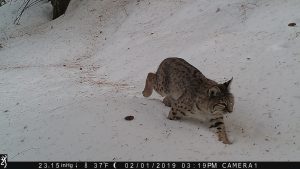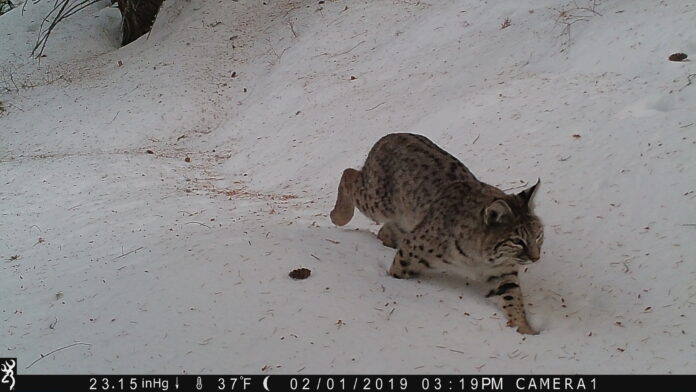BY HANNES THUM

I have been spending a lot of time this winter looking at bobcat tracks.
I keep coming across them, and I always take note when I do. In a canyon west of here, I have skied alongside bobcat tracks in the snow only to return the next week and find that newer bobcat tracks were walking within my ski tracks.
In that area, this winter, the tracks keep appearing.
A while back, I was out on one of the long, windy ridges above that canyon when I came across some fresh tracks in the snow. An adult and a juvenile had been traveling together, as they tend to do until the young cat is old enough to forge its own path. They had come up out of the north-facing woods on one side of the ridge, and had followed the ridge upwards, just as I was doing. They stayed on the wind-stiffened snow that made for easier travel (bobcats, unlike their cousins, the lynx, don’t have very big feet and struggle a bit in deep snow).
I skied alongside the tracks as they climbed higher and higher, until they disappeared under newly wind-drifted snow from that morning, but never saw the cats themselves, even though I was probably just a few hours behind them.
Lots of tracks, but no cat sightings.
Because I know that bobcats are pretty hard to spot (and because I like seeing what kinds of creatures move through the woods when I am not around, anyhow), I like to put motion-sensing trail cameras out in the woods. One of the animals that I most hope to get photos of are bobcats.
Pulling a memory card out of a trail camera that has been out in the wilderness for a while always comes with anticipation. There is always the hope that the camera captured a great photo of a rare animal. It’s not easy to do—I have left some cameras out for months without a single good photo being taken. The most common case, honestly, is that I end up with a card full of uninspiring pictures of the empty woods (a pesky branch blowing in the wind can trigger the camera shutter thousands of times) with a few images of squirrels jumping past or maybe a few deer, too close to or too far from the camera to reveal much. Despite my best plans, it is still hard to capture good images.
Occasionally, though, that tiny little plastic memory card contains some amazing photographs. And, when we pulled a card a few weeks ago out of a camera not far from where I had followed the bobcat tracks along the ridge, it was both surprising and not surprising to see the photo of the bobcat that the camera had captured —there was a bobcat, stepping carefully, head up and eyes alert, through the woods. That elusive creature, finally, caught on film.
Hannes Thum is a Wood River Valley native and has spent most of his life exploring what our local ecosystems have to offer. He currently teaches science at Sun Valley Community School



